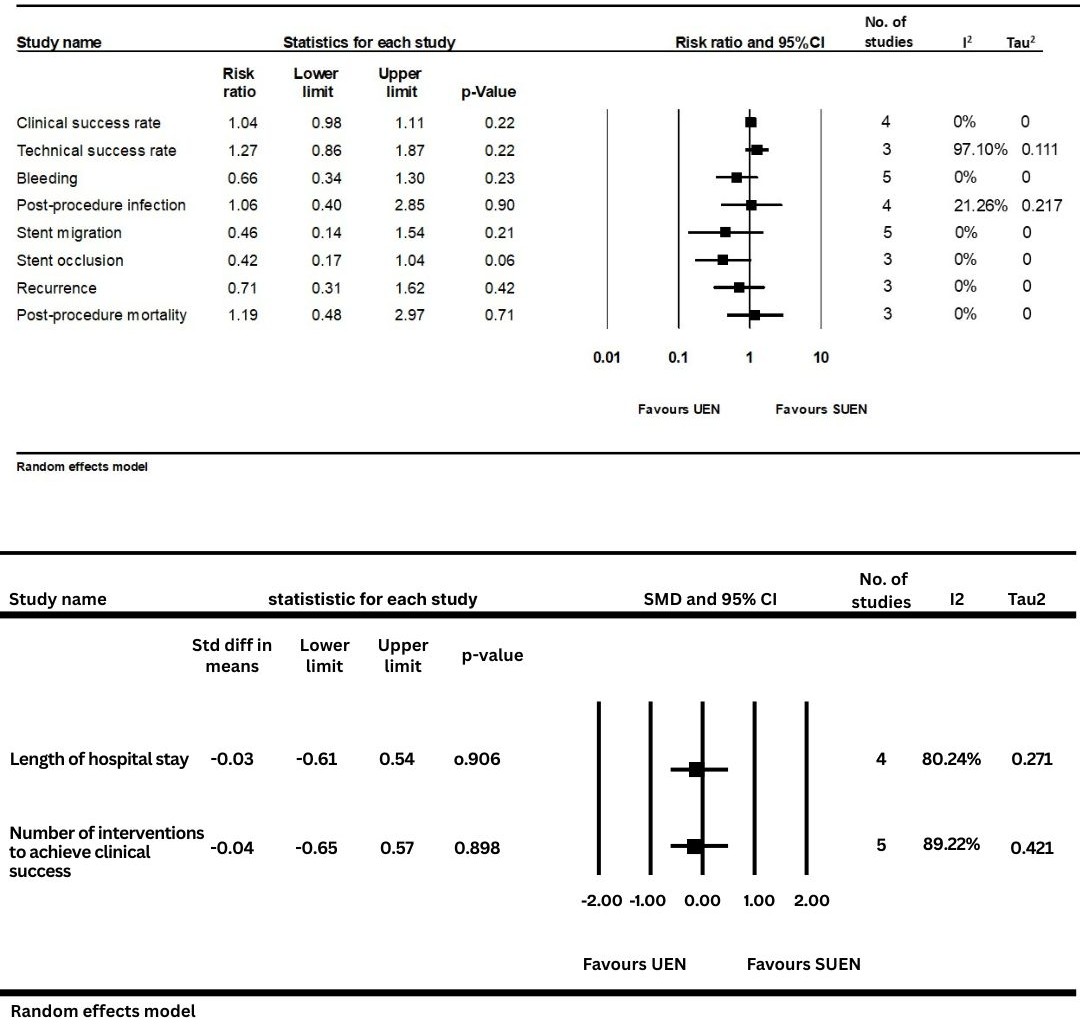Monday Poster Session
Category: Interventional Endoscopy
P3518 - Upfront Endoscopic Necrosectomy vs Step-Up Endoscopic Approach for Walled-Off Pancreatic Necrosis: A Systematic Review and Meta-Analysis
Monday, October 27, 2025
10:30 AM - 4:00 PM PDT
Location: Exhibit Hall

Nkengeh Tazinkeng, MD
Newark Beth Israel Medical Center
Newark, NJ
Presenting Author(s)
Nkengeh Tazinkeng, MD1, Fatima Elmustafa, MBBS2, Kristie Liao, DO3, Divine A. Dele, MD1, Mexan Mapouka, MD4, Nawal Suhail, MD5, Samuel Igbinedion, MD3
1Newark Beth Israel Medical Center, Newark, NJ; 2Henry Ford Warren, Warren, MI; 3University of Tennessee Health Science Center, Chattanooga, TN; 4University of Maryland Capital Region Health, Largo, MD; 5Newark Beth Israel Medical Centre, Newark, NJ
Introduction: Endoscopic necrosectomy has emerged as the preferred method for managing walled-off pancreatic necrosis. Despite the growing adoption of endoscopic techniques, there is limited comparative data with large sample sizes to guide optimal timing and sequencing of interventions. This systematic review evaluated the efficacy and safety of Upfront Endoscopic Necrosectomy (UEN) compared to Step-up Endoscopic Necrosectomy (SUEN) in patients with walled-off pancreatic necrosis.
Methods: Following the PRISMA guidelines, we conducted a comprehensive search on MEDLINE, Embase, Scopus, Web of Science, Cochrane Central Register of Controlled Trials, and ClinicalTrials.gov for articles published from the databases' inception to February 20, 2025. Random-effects meta-analytic models were used to calculate pooled relative risks (RR) or standardized mean differences (SMD) and their 95% confidence intervals (CI) for dichotomous and numerical variables, respectively.
Results: We included five studies with a total sample size of 547 participants. Most of the included studies were retrospective comparative cohort analyses (4/5) and conducted in the USA (4/5). The mean age of participants was 51.74 ± 15.4 years in the UEN group and 53.2 ± 18.0 years in the SUEN group. In terms of efficacy outcomes, we found no significant difference in clinical success rate (1.04; 0.98, 1.11), technical success rate (1.27; 0.86, 1.87), length of hospital stay (-0.03; -0.61, 0.54), and number of interventions required to achieve clinical success (-0.04; -0.65, 0.57), in patients receiving UEN compared to the SUEN group. Similarly, there was no significant difference in safety outcomes such as bleeding (0.66; 0.34, 1.30), post-procedural infection (1.06; 0.40, 2.85), stent migration (0.46; 0.14, 1.54), stent occlusion (0.42; 0.17,1.04), recurrence (0.71; 0.31, 1.62) or post-procedure mortality (1.19; 0.48, 2.97) between both groups.
Discussion: Our study demonstrates that UEN and SUEN perform similarly in terms of commonly measured efficacy and safety endpoints. This finding underscores the importance of individualized treatment in patients with walled-off pancreatic necrosis. While UEN might provide a more convenient resolution in select patients by reducing the burden of multiple procedures, patients at higher risk of complications or those with less mature collections might benefit more from a step-up approach. Our study was limited by the few number of included studies and the observational nature of most included studies.

Figure: Pooled effect sizes of efficacy and safety endpoints in patients receiving UEN vs SUEN
Disclosures:
Nkengeh Tazinkeng indicated no relevant financial relationships.
Fatima Elmustafa indicated no relevant financial relationships.
Kristie Liao indicated no relevant financial relationships.
Divine Dele indicated no relevant financial relationships.
Mexan Mapouka indicated no relevant financial relationships.
Nawal Suhail indicated no relevant financial relationships.
Samuel Igbinedion indicated no relevant financial relationships.
Nkengeh Tazinkeng, MD1, Fatima Elmustafa, MBBS2, Kristie Liao, DO3, Divine A. Dele, MD1, Mexan Mapouka, MD4, Nawal Suhail, MD5, Samuel Igbinedion, MD3. P3518 - Upfront Endoscopic Necrosectomy vs Step-Up Endoscopic Approach for Walled-Off Pancreatic Necrosis: A Systematic Review and Meta-Analysis, ACG 2025 Annual Scientific Meeting Abstracts. Phoenix, AZ: American College of Gastroenterology.
1Newark Beth Israel Medical Center, Newark, NJ; 2Henry Ford Warren, Warren, MI; 3University of Tennessee Health Science Center, Chattanooga, TN; 4University of Maryland Capital Region Health, Largo, MD; 5Newark Beth Israel Medical Centre, Newark, NJ
Introduction: Endoscopic necrosectomy has emerged as the preferred method for managing walled-off pancreatic necrosis. Despite the growing adoption of endoscopic techniques, there is limited comparative data with large sample sizes to guide optimal timing and sequencing of interventions. This systematic review evaluated the efficacy and safety of Upfront Endoscopic Necrosectomy (UEN) compared to Step-up Endoscopic Necrosectomy (SUEN) in patients with walled-off pancreatic necrosis.
Methods: Following the PRISMA guidelines, we conducted a comprehensive search on MEDLINE, Embase, Scopus, Web of Science, Cochrane Central Register of Controlled Trials, and ClinicalTrials.gov for articles published from the databases' inception to February 20, 2025. Random-effects meta-analytic models were used to calculate pooled relative risks (RR) or standardized mean differences (SMD) and their 95% confidence intervals (CI) for dichotomous and numerical variables, respectively.
Results: We included five studies with a total sample size of 547 participants. Most of the included studies were retrospective comparative cohort analyses (4/5) and conducted in the USA (4/5). The mean age of participants was 51.74 ± 15.4 years in the UEN group and 53.2 ± 18.0 years in the SUEN group. In terms of efficacy outcomes, we found no significant difference in clinical success rate (1.04; 0.98, 1.11), technical success rate (1.27; 0.86, 1.87), length of hospital stay (-0.03; -0.61, 0.54), and number of interventions required to achieve clinical success (-0.04; -0.65, 0.57), in patients receiving UEN compared to the SUEN group. Similarly, there was no significant difference in safety outcomes such as bleeding (0.66; 0.34, 1.30), post-procedural infection (1.06; 0.40, 2.85), stent migration (0.46; 0.14, 1.54), stent occlusion (0.42; 0.17,1.04), recurrence (0.71; 0.31, 1.62) or post-procedure mortality (1.19; 0.48, 2.97) between both groups.
Discussion: Our study demonstrates that UEN and SUEN perform similarly in terms of commonly measured efficacy and safety endpoints. This finding underscores the importance of individualized treatment in patients with walled-off pancreatic necrosis. While UEN might provide a more convenient resolution in select patients by reducing the burden of multiple procedures, patients at higher risk of complications or those with less mature collections might benefit more from a step-up approach. Our study was limited by the few number of included studies and the observational nature of most included studies.

Figure: Pooled effect sizes of efficacy and safety endpoints in patients receiving UEN vs SUEN
Disclosures:
Nkengeh Tazinkeng indicated no relevant financial relationships.
Fatima Elmustafa indicated no relevant financial relationships.
Kristie Liao indicated no relevant financial relationships.
Divine Dele indicated no relevant financial relationships.
Mexan Mapouka indicated no relevant financial relationships.
Nawal Suhail indicated no relevant financial relationships.
Samuel Igbinedion indicated no relevant financial relationships.
Nkengeh Tazinkeng, MD1, Fatima Elmustafa, MBBS2, Kristie Liao, DO3, Divine A. Dele, MD1, Mexan Mapouka, MD4, Nawal Suhail, MD5, Samuel Igbinedion, MD3. P3518 - Upfront Endoscopic Necrosectomy vs Step-Up Endoscopic Approach for Walled-Off Pancreatic Necrosis: A Systematic Review and Meta-Analysis, ACG 2025 Annual Scientific Meeting Abstracts. Phoenix, AZ: American College of Gastroenterology.

